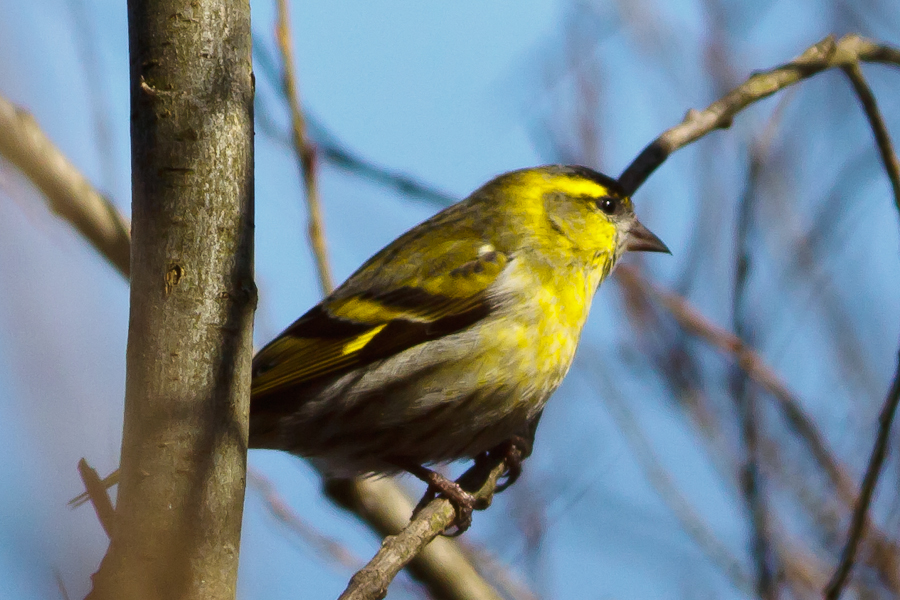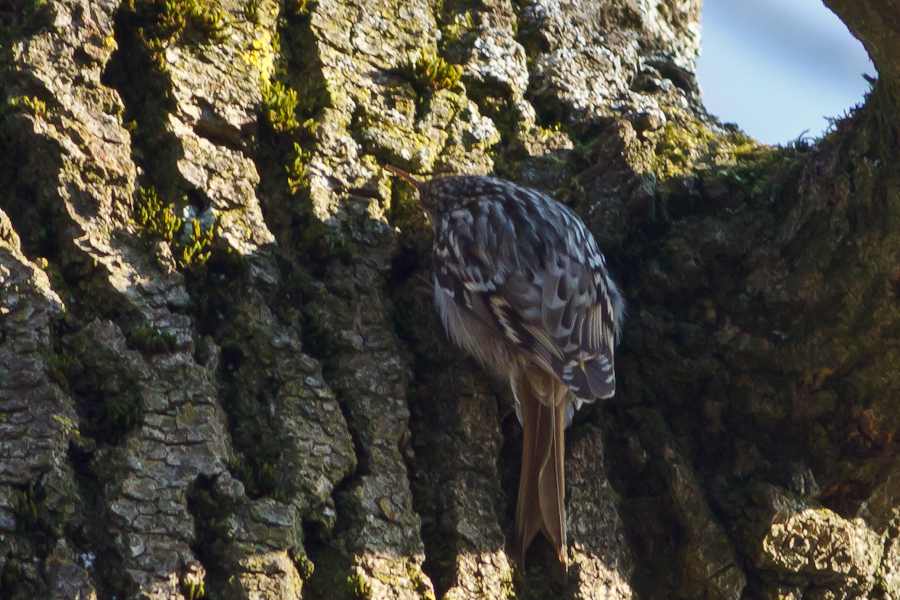#536-538 at the Ammersee
Saturday the weather wasn’t looking good so I stayed close to home, and revisited the English Garden. Fortunately the promised rain never did come, and I managed to explore pretty much the entire garden from one end to the other and back (about eight miles). However it was still relatively quiet. The birdiest spot was in the far northeastern corner where I added a couple of new trip species including Eurasian Jay. A little south of there near what looked like some sort of community garden, I saw one small new bird and heard a second. Unfortunately I couldn’t identify either one. :-( Such are the perils of birding alone in unfamiliar territory.
Saturday afternoon I went back to Park Schloss-Nymphenburg to check out the Wildlife Photographer of the Year Exhibit at the Museum Mensch und Natur. I could have seen this the previous weekend, but I hadn’t known it was there. At least this time I knew where the tram was. :-) I didn’t do any serious birding of the grounds this time, but I did find one really obvious Eurasian Treecreeper with a big white eyebrow. (According to my field guide, in this part of Europe only Eurasian Treecreepers have white eyebrows. Some Eurasian Treecreepers don’t have white eyebrows, but no Short-toed Treecreepers have them.) Update: going over my records, I found that although I have seen Treecreepers before I’ve never had one with enough distinguishing characteristics to conclusively call it a Eurasian Treecreeper. That makes this bird #535!
Sunday, though, was a lot sunnier; and I hopped the train down to Herrsching on the Ammersee. As near as I could tell, this seemed to be the best spot I could reach outside of the city without renting a car. Trains weren’t running frequently on Sunday. I just missed one in Munich so I had to wait 30 minutes at the Hauptbahnhof, and another 15 minutes in Wessling. While waiting to change trains at Wessling, I ticked off a few birds from the platform including a Great Spotted Woodpecker, a European Greenfinch, and the only Eurasian Collared-Dove I saw the entire trip.
I finally reached Herrsching just before 10:00 AM. Given my complete lack of even basic reading German, I wasn’t sure where to go from the train station. I wandered around for a bit looking for a sign that made any sense. I never did find one, but I did find a Marsh Tit. Looks a lot like a Chickadee back home.
I eventually remembered that water flows downhill and into the lake, at least most of the time, and thus was able to point myself toward the lake by orienting along a stream. Turned out I had to go under the train station to reach the other side of town. Once I did that, finding the lake was easy. Herrsching proved to be a lakeside vacation community. It reminds me a little of Block Island. Once I reached the lake, I simply followed the lakefront to see what I could see.
Birds along the lake included Whooper Swan, White Wagtail, Red-crested Pochard, and many Black-headed Gulls. My guidebook had suggested I take the ferry around the Ammersee to several other lakefront towns, and I was hoping to do a little pelagic birding on the way; but it turns out the ferry wasn’t running for another month or so. :-(
Fortunately, a small trail continued around the lakefront even after the paved path ran out, and in a small but of brush between the path and the lake, I saw quite a bit of activity. First was a small olive-brown bird which was wagging its tail. Plumage wise there were two obvious possibilities: Common Chiffchaff and Willow Warbler, either one a lifer. However, only the Chiffchaff wags its tail like that. #536!
And in the same patch of brush I then found several Eurasian Siskins #537! These were easier to identify since they’re more distinctively plumaged, and yet are obviously related to our Pine Siskin back home:

I continued following the lakefront for as far as I was comfortable going. Eventually the path reached a stream crossed by wet boulders. I wasn’t comfortable traversing that with all my camera gear, so I turned around and headed back the other direction. Heading north along the lakefront though there was just some relatively well-manicured parkland and no birds or habitat of interest for some distance. So eventually I returned to my starting point at the train station and decided to climb the mountains behind Hersching around 1:00 PM. In particular I was aiming for Klosters Andech, a local monastery famous for its food and beer.
It wasn’t easy to found the right trail through the town (again, speaking no German). However by following other hikers who I figured were probably going to the same place I managed it. There weren’t a lot of birds along the path though, mostly just some of the same Great Tits I’d been seeing and hearing for the entire trip. However the monastery did have a colony of Jackdaws, a trip bird at least, and the only ones I was to see. Also, the beer really was quite good, as was the food.
Instead of hiking back down the mountain, I caught a local bus back to the train station. By the time I got back at 4:25, dusk was approaching, and the light wasn’t great. Still I figured I was unlikely to return here and should take advantage of what time I had, so I took a another stroll down to the lake. This was fortunate as no sooner had I reached the little park near the waterfront, when I found, and photographed what eventually proved to be a Short-toed Treecreeper, #538!
As I mentioned earlier, this species is almost impossible to distinguish in the field from the closely related Eurasian Treecreeper, but with a photograph you can see the distinguishing marks. In particular look for:
- Browner tinge along the lower flanks
- Even steps along the edge of the wing bar
- Most obvious: distinct white tips on the primaries
The “short toe” that gives the bird its name is only visible on a bird in the hand. This is the main reason I started to carry a camera with me. There are some birds you just can’t ID from binoculars alone.
I rewalked the path along the lake I had followed that morning, but with approaching night, it was much less birdy, and I didn’t add any more new birds to the trip list, so that was it for Germany. Total number of birds for the trip (and Germany) is 49 including 7 life birds:
- Short-toed Treecreeper
- Eurasian Jackdaw
- White Wagtail
- Common Chiffchaff
- Eurasian Siskin
- Eurasian Wren
- Great Crested Grebe
- Marsh Tit
- House Sparrow
- Eurasian Collared-Dove
- European Starling
- Eurasian Jay
- Mandarin Duck
- Fieldfare
- Red-crested Pochard
- Snow Goose
- Black-headed Gull
- Eurasian Treecreeper
- Tawny Owl
- Gadwall
- Crested Tit
- Barnacle Goose
- European Greenfinch
- Common Merganser
- Canada Goose
- Green Woodpecker
- Common Pochard
- European Robin
- Long-tailed Tit
- Great Tit
- Common Moorhen
- Graylag Goose
- Tufted Duck
- Common Wood-Pigeon
- Mallard
- Eurasian Coot
- Bar-headed Goose
- Song Thrush
- Mute Swan
- Mistle Thrush
- Eurasian Blue Tit
- Rock Pigeon
- Great Spotted Woodpecker
- Eurasian Nuthatch
- Eurasian Blackbird
- Carrion Crow
- Common Chaffinch
Plus maybe up to four more species I failed to identify.
I was hoping for more, but either Munich is relatively devoid of natural areas, or I didn’t find the right ones. Still I did get some good birds on this trip including Tawny Owl and Short-toed Treecreeper. If I go back to Munich, I think I’ll have to rent a car next time. There are some nature preserves, marshes, and alpine territory that are of interest, but the best seem inaccessible via public transit. And they’re relatively few common urban park birds left for me to find in Western Europe. I don’t track it precisely, but my European list is now somewhere around 100 species, mostly from areas quite close to city centers. It’s time to spread out a little.


May 16th, 2011 at 9:32 AM
Good bird list for Munich. You are right, Munich itself is pretty devoid of natural areas. But with a car you should be able to visit good places not further away than 90 minutes of drive (Ammersee, Altmühlsee, the Alps, Unterer Inn, etc).
There are great birds in those areas incl. (depending on the area) Red Kite, Golden Eagle, White-tailed Eagle (spectacular bird), White-backed Woodpecker, Black-tailed Godwit, Purple Heron, etc.
If you can read some German, I highly recommend “Vögel beobachten in Süddeutschland” ( 978-3440119280). It is a great book with many detailed maps and descriptions of great birding areas in southern Germany. There are similar books for northern and eastern Germany. Especially eastern Germany is a great place (for example for Lesser Spotted Eagle, Common Crane, Osprey, etc).
Also great (about 5 hours from Munich) is the Neusiedler See National Park and the surrounding areas. It is at the Austrian-Hungarian border (one hour from Vienna) and probably the best birding place in Central Europe. Species incl. Great Bustard, Pygmy Cormorant, 3 Harrier species, Saker Falcon, Eastern Imperial Eagle and many shorebirds.
Markus
May 17th, 2011 at 5:29 AM
Thanks. I’ll keep this in mind if I get the chance to go back.